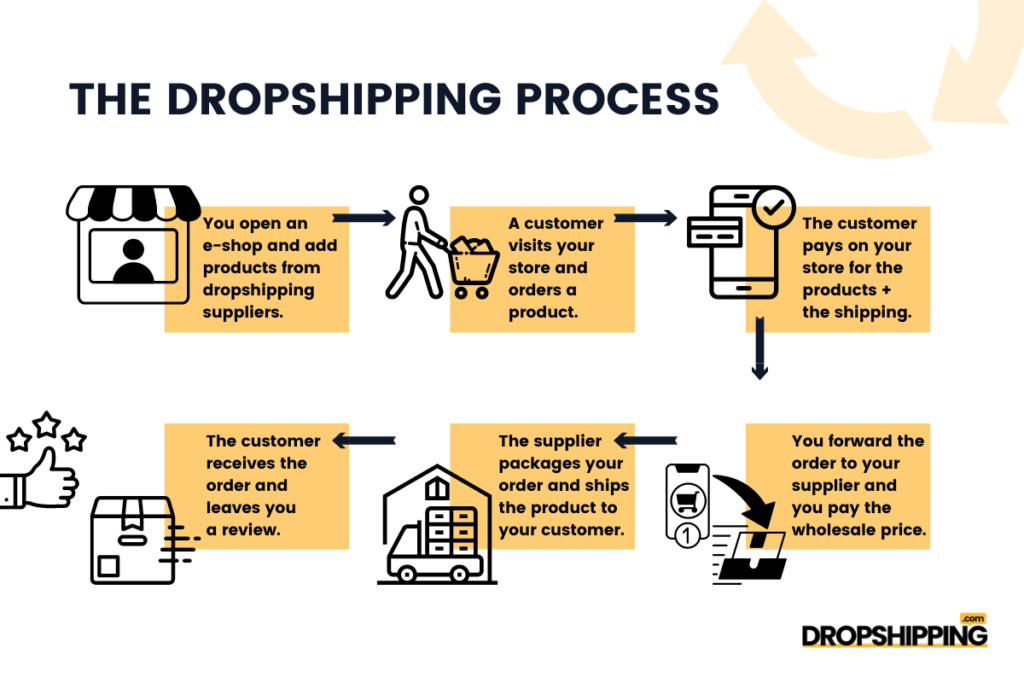Do you have an idea for a product that you truly believe in? Learn how to launch your product as a Private Label Here.
Hello! I’m Devin from BrontoBarton Inc, and I’m excited to introduce you to the world of dropshipping. Dropshipping is a unique approach to e-commerce that allows you to sell products online without stocking them yourself. Here’s how it works:
Core Aspects of Dropshipping:
- Zero Inventory: I’ve seen many entrepreneurs thrive without ever keeping products in stock. This model eliminates the need for large storage spaces and inventory management.
- Diverse Product Range: You can offer a wide array of products. I have successfully sold things from electronics to fashion without owning a single item.
- Reduced Initial Investment: Starting a dropshipping business requires significantly less capital compared to traditional retail. This opens up opportunities for many aspiring entrepreneurs.
- Operational Flexibility: You can run your dropshipping business from anywhere with an internet connection. This flexibility is something that should be highly valued.
- Reliance on Suppliers: The key to success in dropshipping is partnering with reliable suppliers. My experience shows that strong supplier relationships are crucial.
Who Should Consider Dropshipping:
- If you’re looking to start an online business with minimal upfront costs, dropshipping is an excellent option.
- It’s perfect for those who prefer to manage their business remotely.
- Ideal for testing different markets without heavy investment in inventory.
I’ve guided numerous entrepreneurs through the journey of setting up successful dropshipping businesses. It’s a model that offers great potential, but like any business, it requires dedication, market insight, and a focus on customer satisfaction.
Let me answer this question for you – Is Dropshipping for me?
If you’re looking to start an online business with minimal upfront costs, dropshipping is an excellent option.
It’s perfect for those who prefer to manage their business remotely.
Ideal for testing different markets without heavy investment in inventory.

Market Research in Dropshipping: Picking Your Niche
Hello again! Let’s dive into one of the most critical steps in starting your dropshipping business: Market Research, particularly focusing on picking your niche.
Why Picking a Niche is Essential:
- Targeted Marketing: By selecting a specific niche, you can tailor my marketing efforts to a particular audience, making them more effective and cost-efficient.
- Establishing Expertise: Focusing on a niche allows me to build a reputation as an expert in that area. Customers often prefer to buy from specialized stores.
- Lower Competition: In a specific niche, you will face less competition compared to broader markets, allowing for a more focused strategy and potentially higher profit margins.
How to Pick a Niche:
- Identify Your Interests and Passions: I always suggest starting with what you know and love. Passion for your products can translate into better customer service and marketing.
- Market Demand Research: Use tools like Google Trends, social media listening, and keyword research to understand what products are in demand. This data-driven approach helps in making informed decisions.
- ALSO: Tiktok is great for finding products! Through my journey I learned about these following keywords where you can find some neat stuff ‘Tiktok made me buy this’ ‘I want a refund’
- Another good search engine for products is Minea.com it is not free but an absolute cheat code that will keep you ahead of people that aren’t using it. If you take this as serious as I know you can, your work ethic plus Minea will make you unstoppable. Click Here to sign up for Minea now
- Check the Competition: Look at competitors in your potential niche. Are they thriving? What gaps can you fill? This helps to validate the market and find a unique angle.
- Profit Margins: Analyze the potential profit margins. Higher priced niches often mean higher profits but may require more convincing sales strategies.
- Supplier Availability: Ensure there are reliable suppliers for your chosen niche. Having multiple suppliers can mitigate risks.
- Scalability: Consider how the niche can grow over time. Can you expand your product range within the niche? Is the market likely to sustain in the long term?
Picking the right niche is the foundation of your dropshipping business. It should align with your interests, have a demand in the market, and offer room for growth and profitability. Remember, the niche you choose sets the tone for your entire business strategy.
Finding Suppliers for Your Dropshipping Business
Another crucial aspect of building a successful dropshipping business: Finding the right suppliers. This step can make or break your business, so let’s get it right.
The Importance of Reliable Suppliers:
- Product Quality: The supplier determines the quality of products that you sell. High-quality products lead to customer satisfaction and repeat business.
- Shipping Times: You will need suppliers who can ship products promptly. Faster delivery times enhance customer satisfaction.
- Inventory Stability: Reliable suppliers mean stable inventory. It’s essential to have consistent product availability to maintain sales and customer trust.
Steps to Find the Right Suppliers:
- Research and List Potential Suppliers: Use a platform like AliExpress or Oberlo to find suppliers in your niche. I always recommend creating a list of potential suppliers to compare.
- Evaluate Supplier Performance: Look at supplier ratings, reviews, and history. This step helps me gauge their reliability and quality of service. Develop a habit of checking the 2 star ratings and one star ratings to see what people are saying.
- Communicate with Suppliers: I reach out to potential suppliers to discuss terms, understand their processes, and gauge their communication efficiency. Clear communication is key in a successful partnership.
- Order Samples: Before finalizing a supplier, I order samples. This gives me firsthand experience of what my customers will receive in terms of product quality and shipping times.
- Negotiate Terms: Once I’ve chosen a supplier, I negotiate terms like pricing, minimum order quantities, and return policies. It’s crucial to establish clear terms from the beginning.
- Build a Relationship: I believe in building a strong, mutually beneficial relationship with suppliers. This can lead to better terms and priority treatment in the future.
Remember, finding the right supplier is a critical process that requires time and careful consideration. It’s not just about finding the cheapest option but about ensuring quality, reliability, and a partnership that can support the growth of your dropshipping business.
Setting Up an Online Store for Dropshipping
After selecting your niche and finding suppliers, the next big step is setting up your online store. This is where your customers will interact with your brand, so it’s crucial to get it right.
Key Considerations for Your Online Store:
- Choosing the Right E-Commerce Platform: Platforms like Shopify, WooCommerce, and BigCommerce are popular for dropshipping. I recommend Shopify for beginners for its ease of use and dropshipping-friendly features. Highly Recommended for this course here. Click Here to start building on Shopify
- Designing Your Store: The design should be clean, user-friendly, and aligned with your brand. Ensure your website is easy to navigate and looks professional. First impressions matter a lot in e-commerce.
- Setting Up Payment Processing: Offer multiple payment options like credit cards, PayPal, and Apple Pay. Ensure your payment gateway is secure and reliable.
- Integrating with Suppliers: Many e-commerce platforms allow integration with dropshipping suppliers. This automation makes order fulfillment smoother and reduces manual errors.
- Mobile Responsiveness: A significant portion of online shopping is done on mobile devices. Ensure your site is fully responsive and looks great on all devices.
- SEO and Content Strategy: Optimize your site for search engines to attract organic traffic. Include a blog to provide valuable content related to your niche, which can improve SEO and engage customers.
- Legalities: Make sure to include necessary policies on your site, such as privacy policy, return policy, and terms of service.
- Testing: Before going live, test your website thoroughly. Check for any bugs, ensure all links work, and the checkout process is smooth.
Launching Your Store:
Once everything is set up, it’s time to launch your store. But remember, launching is just the beginning. Continuous improvement based on customer feedback and analytics is key to long-term success.
Your online store is the face of your dropshipping business. Take the time to set it up correctly, ensuring it’s user-friendly, visually appealing, and functional. A well-set-up store lays a strong foundation for attracting and retaining customers.
Digital Marketing for Your Dropshipping Business
Once your online store is set up, the next crucial step is digital marketing. In the world of dropshipping, effective digital marketing can be the difference between a thriving business and one that struggles to find customers.
Essential Digital Marketing Strategies:
- Search Engine Optimization (SEO): Optimize your website for search engines to improve visibility. This includes using the right keywords, creating quality content, and ensuring your website has a fast loading speed. SEO helps in attracting organic, targeted traffic to your site. (Maybe out source a video on how SEO works)
- Social Media Marketing: Utilize social media platforms to connect with your audience. Platforms like Facebook, Instagram, and Pinterest are great for visual products. Regular posting, engaging with followers, and using targeted ads can significantly boost your brand’s presence and sales.
- Email Marketing: Collect email addresses from your website visitors (with their permission) and keep them engaged with regular updates, promotions, and personalized offers. Email marketing is a powerful tool for customer retention and driving repeat sales. MailChimp or ActiveCampaign are my personal choices. For this course, it is not absolutely essential, however having it and understanding how it works will allow you to build a strong email list and bond with your customers and alert them when you have new products to sell. See More about Email Marketing.
- Content Marketing: Create and share valuable content related to your niche. This can include blog posts, videos, infographics, or podcasts. Quality content can help establish your brand as an authority in your niche and drive traffic to your site. (Maybe show an example of how to create a product marketing content)
- Pay-Per-Click Advertising (PPC): Use PPC campaigns through Google Ads or social media platforms to drive targeted traffic to your site. PPC can be particularly effective for generating sales quickly, though it requires a budget for advertising. Furthermore, Tiktok has paid advertising. This allows huge advantages for great short copy content to reach out to a ton of viewers.
- Influencer Partnerships: Collaborating with influencers in your niche can be a highly effective way to reach a broader audience. Influencers can provide credibility and a considerable boost in visibility.
- Analytics and Adjustment: Regularly analyze the performance of your marketing strategies using tools like Google Analytics. Understanding what works and what doesn’t allows you to refine your approach and invest more effectively.
Tips for Successful Digital Marketing:
- Know Your Audience: Tailor your marketing strategies to your target audience. Understanding their preferences, pain points, and behaviors can make your marketing efforts more effective.
- Consistency is Key: Regular and consistent marketing efforts help in building brand recognition and customer trust.
- Be Adaptable: Digital marketing trends and algorithms change frequently. Stay updated and be willing to adapt your strategies accordingly.
Effective digital marketing is about connecting with your audience, providing value, and using the right channels and strategies to reach them. It’s a continuous process of learning, testing, and adjusting.
Order Fulfillment and Customer Service in Dropshipping
Let’s talk about two pivotal aspects of running a successful dropshipping business: Order Fulfillment and Customer Service.
Order Fulfillment in Dropshipping:
- Automated Order Processing: Most dropshipping businesses use e-commerce platforms that automate the order fulfillment process. DSers for AliExpress is a good example. When a customer places an order, it’s automatically forwarded to the supplier for shipping. It’s vital to ensure that this process is seamless.
- Tracking and Communication: Provide customers with tracking information once their orders are shipped. Keeping customers informed about their order status is crucial for a positive shopping experience.
- Handling Delays and Issues: If there are delays or issues with an order, proactive communication is key. Inform the customer promptly and offer solutions or compensations if necessary.
- Quality Control: Regularly order samples from your suppliers to check the quality of products and packaging. This helps in maintaining the quality of products that your customers receive.
Customer Service Excellence:
- Responsive Support: I emphasize offering prompt and helpful customer support. Whether it’s via email, chat, or phone, responsiveness can significantly impact customer satisfaction and loyalty.
- Clear Policies: Have clear and easily accessible policies on your website regarding returns, refunds, and exchanges. Transparency in policies builds trust with your customers.
- Feedback Loop: Encourage and pay attention to customer feedback. This can be through reviews, surveys, or direct communication. Feedback is invaluable for improving your products and services.
- Going the Extra Mile: Small gestures like personalized thank-you emails, discount codes for future purchases, or addressing customer concerns with empathy can go a long way in building a loyal customer base.
Why It Matters:
- Good order fulfillment and customer service create repeat customers and positive word-of-mouth.
- They are key differentiators in a competitive market. Many businesses sell similar products, but excellent customer service can make your business stand out.
- They directly impact the reputation and long-term success of your business.
- It is essential when you’re doing little to no cost because you do not have the product. So communicating with your customers accurately as possible about supply and delivery will suppress aggravation about delivery issues.
In dropshipping, where you have less control over inventory and shipping, excellence in these areas becomes even more crucial. It’s about creating a positive customer experience, from the moment they place an order to post-purchase support.
Scaling and Managing Your Dropshipping Business
Now, let’s explore how to effectively scale and manage your dropshipping business. Growing your business is not just about increasing sales; it’s about strategically scaling and managing operations to sustain that growth.
Strategies for Scaling Your Dropshipping Business:
- Expand Your Product Line: Once you’ve established a successful product range, consider diversifying your offerings. But, always ensure the new products align with your brand and customer interests.
- Optimize Your Website: As your traffic increases, continuously optimize your website for speed, user experience, and SEO. A well-optimized website can handle more traffic and convert more sales.
- Invest in Marketing: Reinvest profits into your marketing efforts. More sophisticated marketing techniques, like retargeting ads and advanced SEO, can drive further growth.
- Explore New Markets: Consider expanding into new geographical markets if your supplier’s shipping capabilities allow. This can significantly increase your customer base.
- Automation and Technology: Implement more advanced automation tools for things like email marketing, customer service, and inventory management to handle increased volume efficiently.
- Outsource When Necessary: As your business grows, consider outsourcing tasks like customer service, content creation, or PPC management to experts. This frees up your time to focus on strategy and growth.
Managing Your Business Effectively:
- Financial Management: Keep a close eye on your finances. Use accounting software to track revenues, expenses, and profitability. Regular financial analysis is crucial for informed decision-making.
- Customer Feedback and Adaptation: Continuously collect and analyze customer feedback. Adapting based on customer needs and market trends is key to staying relevant and competitive.
- Supplier Relationships: Maintain strong relationships with your suppliers. Good relationships can lead to better prices, terms, and priority treatment in times of high demand.
- Stay Informed and Flexible: The e-commerce and dropshipping landscapes are always evolving. Stay informed about industry trends and be flexible to adapt your business model when necessary.
Why Proper Scaling and Management Matter:
- Controlled scaling ensures that growth doesn’t compromise quality or customer service.
- Effective management means dealing with increased complexity in operations, finances, and logistics.
- Sustainable growth is about balancing expansion with stability and efficiency.
Scaling and managing a dropshipping business requires a blend of strategic planning, reinvestment, and continuous improvement. It’s a journey of finding what works best for your business while maintaining a commitment to quality and customer satisfaction.
Legal and Ethical Considerations in Dropshipping
Let’s discuss the legal and ethical considerations vital for running a successful and responsible dropshipping business.
Legal Considerations:
- Business Registration: Ensure your business is legally registered. This might involve setting up a sole proprietorship, LLC, or corporation, depending on your location and business structure.
- Tax Obligations: Understand and comply with tax regulations both in your home country and in the countries where you sell. This includes sales tax, income tax, and any other relevant taxes.
- Consumer Protection Laws: Adhere to consumer protection laws which cover product safety, accurate advertising, and fair business practices. It’s crucial to be transparent with customers about prices, returns, and shipping times.
- Privacy Policies: With the importance of data protection, ensure you have a robust privacy policy that complies with laws like GDPR in Europe or CCPA in California, if applicable.
- Intellectual Property: Avoid selling counterfeit or infringing products. Respecting intellectual property rights is crucial to avoid legal issues and maintain your business’s integrity.
- Import and Export Regulations: Be aware of any import and export laws that might affect your products, especially if you’re selling internationally.
Ethical Considerations:
- Supplier Ethics: Choose suppliers who adhere to ethical practices, including fair labor practices and environmental sustainability. Ethical sourcing reflects positively on your brand.
- Honest Marketing: Be honest and clear in your marketing and advertising. Avoid making false claims about products or unrealistic promises about shipping times.
- Quality Assurance: Ensure the products you’re selling meet certain quality standards and are safe for consumers. Regular quality checks are essential.
- Customer Transparency: Be transparent with your customers about shipping times, product origins, and your business model if necessary. Trust is a crucial aspect of customer loyalty.
- Environmentally Friendly Practices: Consider the environmental impact of your products and shipping. Offering eco-friendly products or packaging can be a unique selling point and is beneficial for the environment.
Why Legal and Ethical Practices are Important:
- They build trust with your customers, which is vital for long-term business success.
- Compliance with legal and ethical standards protects your business from legal issues and potential fines.
- Ethical business practices enhance your brand reputation and can differentiate your business in a competitive market.
Navigating the legal and ethical aspects of a dropshipping business is crucial. It ensures not only the longevity and credibility of your business but also contributes positively to customer trust and brand reputation.
Resources and Tools for Dropshipping Success
To wrap up our dropshipping guide, let’s look at some essential resources and tools that can help streamline and enhance your dropshipping business.
Essential Tools for Dropshipping:
- E-commerce Platforms: Shopify is my personal top choice for building your online store. They offer user-friendly interfaces, customizable templates, and various integrations.
- Supplier Directories: Platforms like AliExpress, Oberlo, and SaleHoo can help you find and connect with numerous suppliers worldwide.
- Market Research Tools: Google Trends and SEMrush, provide insights into market trends, keyword popularity, and competitor analysis.
- SEO and Analytics Tools: Google Analytics and Ahrefs are invaluable for tracking your website’s performance and optimizing your SEO strategy.
- Email Marketing Software: Tools like Mailchimp, Activecampaign or Hubspot offer powerful features for email marketing campaigns, customer segmentation, and automation.
- Social Media Management: Buffer and Hootsuite are great for scheduling posts, managing multiple social media accounts, and tracking engagement.
- Customer Service Tools: Zendesk and Freshdesk can help manage customer queries and provide efficient customer support.
- Graphic Design Tools: Canva and Adobe Spark are user-friendly options for creating high-quality graphics for your website and marketing materials.
- Payment Processors: PayPal, Stripe, and Square are reliable payment processing services that offer secure transactions for your customers.
Additional Resources:
- Educational Content: Blogs, podcasts, and YouTube channels focused on e-commerce and dropshipping can be excellent sources of ongoing information and tips.
- Online Courses: Platforms like Udemy and Coursera offer comprehensive courses on dropshipping, digital marketing, and e-commerce strategies.
- Community Forums and Groups: Online communities like Reddit’s r/dropship and LinkedIn groups can provide peer support, advice, and networking opportunities.
- Books: There are numerous books on e-commerce and entrepreneurship that can offer deeper insights and strategies for building a successful business.
Why These Resources Matter:
- They provide the technical backbone for running your online store efficiently.
- They offer insights into market trends, customer behavior, and effective strategies.
- Continuous learning and adapting are key in the ever-evolving world of e-commerce and dropshipping.
As you embark on your dropshipping journey, these tools and resources will be invaluable in helping you build, manage, and grow your business. Remember, the world of e-commerce is dynamic, so staying informed and adaptable is crucial.
You got this, nothing you put your all into wont fail! Let’s go.




